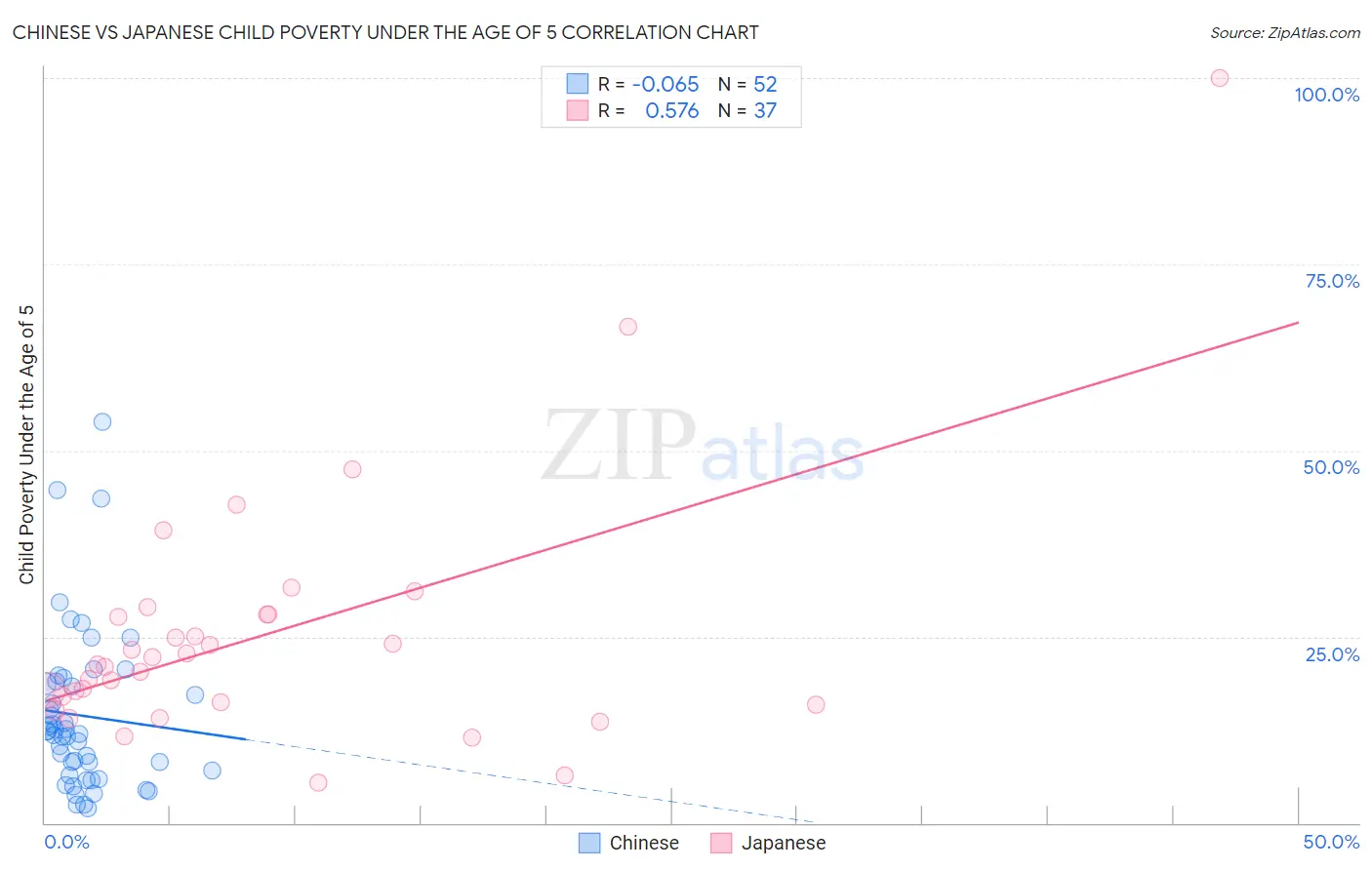Chinese vs Japanese Child Poverty Under the Age of 5
COMPARE
Chinese
Japanese
Child Poverty Under the Age of 5
Child Poverty Under the Age of 5 Comparison
Chinese
Japanese
13.1%
CHILD POVERTY UNDER THE AGE OF 5
100.0/ 100
METRIC RATING
7th/ 347
METRIC RANK
18.1%
CHILD POVERTY UNDER THE AGE OF 5
13.8/ 100
METRIC RATING
202nd/ 347
METRIC RANK
Chinese vs Japanese Child Poverty Under the Age of 5 Correlation Chart
The statistical analysis conducted on geographies consisting of 64,186,861 people shows a slight negative correlation between the proportion of Chinese and poverty level among children under the age of 5 in the United States with a correlation coefficient (R) of -0.065 and weighted average of 13.1%. Similarly, the statistical analysis conducted on geographies consisting of 243,928,105 people shows a substantial positive correlation between the proportion of Japanese and poverty level among children under the age of 5 in the United States with a correlation coefficient (R) of 0.576 and weighted average of 18.1%, a difference of 38.2%.

Child Poverty Under the Age of 5 Correlation Summary
| Measurement | Chinese | Japanese |
| Minimum | 1.9% | 5.4% |
| Maximum | 53.8% | 100.0% |
| Range | 52.0% | 94.6% |
| Mean | 14.4% | 25.2% |
| Median | 12.1% | 21.3% |
| Interquartile 25% (IQ1) | 6.7% | 16.0% |
| Interquartile 75% (IQ3) | 18.8% | 28.1% |
| Interquartile Range (IQR) | 12.1% | 12.0% |
| Standard Deviation (Sample) | 10.8% | 17.1% |
| Standard Deviation (Population) | 10.7% | 16.9% |
Similar Demographics by Child Poverty Under the Age of 5
Demographics Similar to Chinese by Child Poverty Under the Age of 5
In terms of child poverty under the age of 5, the demographic groups most similar to Chinese are Iranian (13.1%, a difference of 0.020%), Immigrants from Iran (13.1%, a difference of 0.17%), Immigrants from Singapore (12.9%, a difference of 0.98%), Burmese (13.2%, a difference of 1.3%), and Immigrants from Korea (13.2%, a difference of 1.4%).
| Demographics | Rating | Rank | Child Poverty Under the Age of 5 |
| Immigrants | India | 100.0 /100 | #1 | Exceptional 11.5% |
| Immigrants | Taiwan | 100.0 /100 | #2 | Exceptional 11.6% |
| Filipinos | 100.0 /100 | #3 | Exceptional 11.6% |
| Thais | 100.0 /100 | #4 | Exceptional 12.3% |
| Immigrants | Hong Kong | 100.0 /100 | #5 | Exceptional 12.4% |
| Immigrants | Singapore | 100.0 /100 | #6 | Exceptional 12.9% |
| Chinese | 100.0 /100 | #7 | Exceptional 13.1% |
| Iranians | 100.0 /100 | #8 | Exceptional 13.1% |
| Immigrants | Iran | 100.0 /100 | #9 | Exceptional 13.1% |
| Burmese | 100.0 /100 | #10 | Exceptional 13.2% |
| Immigrants | Korea | 100.0 /100 | #11 | Exceptional 13.2% |
| Immigrants | South Central Asia | 100.0 /100 | #12 | Exceptional 13.3% |
| Bhutanese | 100.0 /100 | #13 | Exceptional 13.4% |
| Okinawans | 100.0 /100 | #14 | Exceptional 13.4% |
| Indians (Asian) | 100.0 /100 | #15 | Exceptional 13.4% |
Demographics Similar to Japanese by Child Poverty Under the Age of 5
In terms of child poverty under the age of 5, the demographic groups most similar to Japanese are Ugandan (18.0%, a difference of 0.020%), Immigrants from Cambodia (18.1%, a difference of 0.020%), Iraqi (18.0%, a difference of 0.030%), Immigrants from Eastern Africa (18.1%, a difference of 0.080%), and Spaniard (18.1%, a difference of 0.21%).
| Demographics | Rating | Rank | Child Poverty Under the Age of 5 |
| Sierra Leoneans | 24.1 /100 | #195 | Fair 17.7% |
| Immigrants | Portugal | 22.2 /100 | #196 | Fair 17.8% |
| Immigrants | Kenya | 20.0 /100 | #197 | Fair 17.9% |
| Celtics | 18.3 /100 | #198 | Poor 17.9% |
| Hungarians | 18.3 /100 | #199 | Poor 17.9% |
| Iraqis | 14.0 /100 | #200 | Poor 18.0% |
| Ugandans | 13.9 /100 | #201 | Poor 18.0% |
| Japanese | 13.8 /100 | #202 | Poor 18.1% |
| Immigrants | Cambodia | 13.7 /100 | #203 | Poor 18.1% |
| Immigrants | Eastern Africa | 13.4 /100 | #204 | Poor 18.1% |
| Spaniards | 12.8 /100 | #205 | Poor 18.1% |
| Whites/Caucasians | 12.6 /100 | #206 | Poor 18.1% |
| Immigrants | Immigrants | 9.9 /100 | #207 | Tragic 18.2% |
| Scotch-Irish | 9.8 /100 | #208 | Tragic 18.2% |
| Spanish | 9.8 /100 | #209 | Tragic 18.2% |